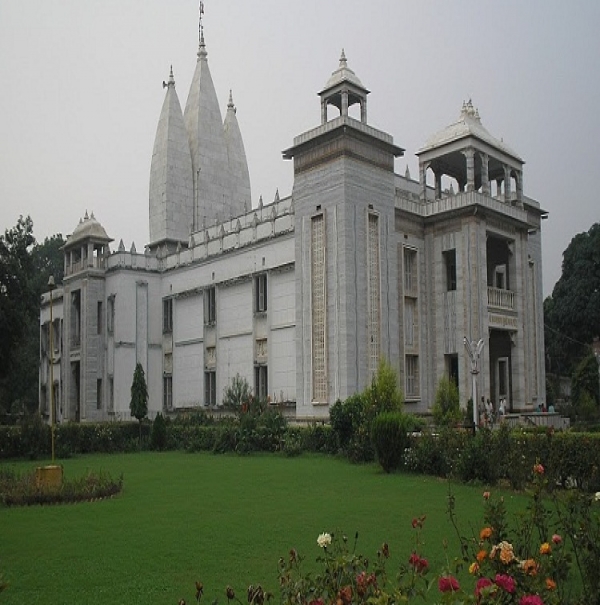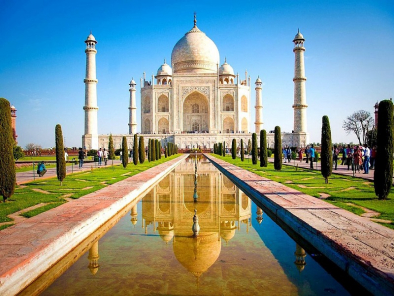
Sign Up
Already a member? Login
Uttar Pradesh is known for its rich culture and tradition. It is home to Ayodhya and Mathura birthplace of Lord Rama, Lord Krishna and Bhgwan Parshuram respectively. Uttar Pradesh attracts many national and international tourists.

On arrival at Delhi. Check in into hotel. Delhi - India’s capital territory, is a massive metropolitan area in the country’s north. In Old Delhi, a neighborhood dating to the 1600s stands the imposing Mughal-era Red Fort, a symbol of India, and the sprawling Jama Masjid mosque, whose courtyard accommodates 25,000 people. Nearby is ChandniChowk, a vibrant bazaar filled with food carts, sweets shops and spice stalls. On arrival check in into hotel, Later proceed to local sightseeing: Rashtrapati Bhawan The wonder of the Rashtrapati Bhavan is multi-dimensional. It is a huge mansion, and its architecture is simply stunning. It was Sir Lutyens who conceptualised this H-shaped building, covering an area of 5 acres on a 330-acre estate. Rashtrapati Bhavan comprises 340 rooms spread over four floors, 2.5 kilometres of corridors and 190 acres of garden area. India Gate: The India Gate is a war memorial nestled astride the Rajpath, on the eastern edge of the "ceremonial axis" of New Delhi. It was earlier called Kingsway. It stands as a memorial to 70,000 soldiers of the British Indian Army who lost their lives between 1914–1921 in the First World War. It is one of the most visited places in Delhi. Red Fort - The Red Fort or Lal Qila is a historic fort in Old Delhi, Delhi in India that served as the main residence of the Mughal Emperors. Emperor Shah Jahan commissioned construction of the Red Fort on 12 May 1638, when he decided to shift his capital from Agra to Delhi. Jamma Masjid – The Masjid-iJehan-Numa, commonly known as the Jama Masjid of Delhi, is one of the largest mosques in India. It was built by the Mughal Emperor Shah Jahan between 1650 and 1656, and inaugurated by its first Imam, Syed Abdul Ghafoor Shah Bukhari. Raj Ghat - Today, Raj Ghat stands as one of the top places to visit in Delhi due to its historical and national significance. The memorial is kept decorated with fresh flowers every day and is visited by both Indian and foreign tourists. Even delegates, dignitaries, and VIPs arriving from other countries make it a point to visit the memorial and pay their respect to the departed soul of Mahatma Gandhi. Overnight stay at Delhi hotel.


Today morning after breakfast proceed for visit to Humayun’s Tomb- It was built in 1565 A.D. nine years after the death of Humayun, by his senior widow Bega Begam. Inside the walled enclosure the most notable features are the garden squares (chaharbagh) with pathways water channels, centrally located well proportional mausoleum topped by double dome. There are several graves of Mughal rulers located inside the walled enclosure and from here in 1857 A.D; Lieutenant Hudson had captured the last Mughal emperor Bahadur Shah II. Qutub Minar - also spelled Qutb Minar and Qutab Minar, is a minaret and "victory tower" that forms part of the Qutb complex, which lies at the site of Delhi’s oldest fortified city, LalKot, founded by the TomarRajputs. It is a UNESCO World Heritage Site in the Mehrauli area of South Delhi, India. The Lotus Temple - While most of the emperors built monuments to glorify themselves or their respective faiths. The Lotus temple, on the other hand, has a unique purpose. It is shaped in the form of a flower which is considered a sacred symbol by most Indians. It symbolizes all those things that people of the Baha'i faith believe in. Overnight at stay Delhi hotel.



Today morning after breakfast check out from hotel and proceed to Agra. En-Route visit to Mathura and Vrindavan. The holy town of Vrindavan, near Mathura is an important pilgrimage hub in Braj region that attracts an estimated 5,00,000 pilgrims every year. This is the place where Lord Krishna is believed to have spent his childhood. The name of Vrindavan comes from words 'vrinda', which means basil, and 'van' meaning forest. Mathura is one of the seven sacred cities of the Hindus. It is the traditional birthplace of the god Krishna (Krishna Janmabhoomi) and the primary site of pilgrimage for the annual celebration of Janmashtami. Visit to Lord Dwarkadhish temple, Adi Shri Keshav Dev Maharaj Mandir, Vishramghat, Banke Bihari Temple, Prem Mandir, Pagal Baba Temple. Later continue drive to Agra - A city on the banks of the Yamuna River. Agra is best known for the Taj Mahal (17th century), designated a UNESCO World Heritage site in 1983. A complex mausoleum, the Taj Mahal is often considered to be the world's best example of Mughal architecture. On arrival check in at hotel. Overnight stay at Agra hotel.



Today after breakfast proceed for visit to Agra Fort and the world famous Taj Mahal. The Taj Mahal, is an Islamic ivory-white marble mausoleum on the right bank of the river Yamuna in the Indian city of Agra. It was commissioned in 1632 by the Mughal emperor Shah Jahan to house the tomb of his favourite wife, Mumtaz Mahal; it also houses the tomb of Shah Jahan himself. Agra Fort - Agra fort is a historical fort in the city of Agra in India. It was built during 1565-1573 for Mughal Emperor Akbar. It was the main residence of the rulers of Sikarwar clan of Rajputs until mughals occupied it and Mughal Dynasty until 1638, when the capital was shifted from Agra to Delhi. Overnight stay at Agra hotel.
Please note : Taj Mahal is closed on Friday.


Today after breakfast drive for Lucknow - The City of Nawabs. It has always been a multicultural city. Courtly manners, beautiful gardens, poetry, music, and fine cuisine patronized by the Persian-loving Shia Nawabs of the city are well known amongst Indians and students of South Asian culture and history. On arrival check in into hotel. Later proceed for visit to Bara Imambara, Chota Imambara, Clock Tower, Rumi Darwaza. Overnight stay at hotel.



Today morning after breakfast check out from hotel and drive for the legendary city of Ayodhya, popularly identified as the present-day Ayodhya, is the birthplace of the Hindu deity Rama of Kosala and setting of the great epic Ramayana and its many versions. On arrival check in into hotel. Visit to Ramabhoomi - birthplace of Rama, Hanuman Garh, Lakshman ghat, Kanak bhavan and Nageshwarnath Temple. Overnight stay at Ayodhya.



Today morning check out from hotel and drive for Prayagraj (Allahabad) is famous for its Kumbh Mela that is organised once every 12 years. It is also famous for Triveni Sangam - the point where Yamuna, Ganga, and Saraswati rivers meet. On arrival check in into hotel. Later visit Triveni Sangam in Prayagraj – confluence point of river Ganga, Yamuna, and Saraswati, Akshayavat Temple (one of the Fifty two Shaktipeethas) and enjoy boat ride at river Ganga, witness Gangaarti in the evening. Overnight stay at Prayagraj.



Arrival at Varanasi. Varanasi - Varanasi is a city in the northern Indian state of Uttar Pradesh dating to the 11th century B.C. Regarded as the spiritual capital of India, the city draws Hindu pilgrims who bathe in the Ganges River’s sacred waters and perform funeral rites. Along the city's winding streets are some 2,000 temples, including Kashi Vishwanath, the “Golden Temple,” dedicated to the Hindu god Shiva. Varanasi is famous for its production of silks and brocades with gold and silver thread work. A renowned carpet-weaving centre is at Bhadoi. Wooden toys, bangles made of glass, ivory work, and brassware are also produced in Varanasi. The city is host to numerous religious festivals. On arrival check in into hotel. Later proceed for visit Kashi Vishvanath Temple (One of the Twelve Jyotirling), Meerghat - Vishalakshi Temple (one of the Fifty two Shaktipeethas), Kalbhairav Temple, Durga Temple, Maha Mrityunjay Temple, Kaudi Mata Temple, Sankat Mochan Temple, Tulsi Manas Temple, Tridev Temple. Overnight stay at Varanasi hotel.



Today morning after breakfast proceed for visit to Sarnath. Sarnath is one of the most important, sacred and famous religious as well as pilgrimage place for the Buddhist World and as this is well known that this place is directly associated with the life and teachings of Lord Buddha From this place Lord Buddha has started the journey of Dhamma by giving his first sermon. Later drive back to Varanasi. Later visit to Varanasi Ghat, here you can take a boat ride in river Ganges and also enjoy the Ganga arti. Overnight stay at Varanasi.



Today after morning breakfast check out from hotel and transfer to Delhi Airport / Railway Station for your onward journey!



Today morning after breakfast proceed to Gaya, visit Vishnupad temple - 220 year old temple dedicated to Lord Vishnu. Visit Maha Bodhi tree where Gautam Buddha was enlightened to the Knowledge of Spiritual World & Lotus tank - where it is believed that Buddha spent one week, Also visit archaeological museum. Overnight stay at Bodh Gaya hotel.



Today morning after breakfast check out out from Bodh Gaya hotel and proceed to Patna. En-route enjoy a roap way ride to visit Vishwa shanti Stupa at Rajgir - Rajgir is famous for the seven hot springs or Saptarshi, which come and mingle together into a big pool of warm water, named Brahmakund. This is a holy place for bathing of the Hindus, Buddhists and Jains alike. Later continue to Nalanda - is famous all over the world for the the ancient International Monastic University established in 5th century BC, which taught Vedas, Logic, Grammar, Medicine, Meta-Physics, Prose Composition and Rhetoric. Visit Nalanda University - one of the greatest learning centres in ancient India. Also visit to Nalanda Museum. Later proceed to Patna - Besides being the birthplace of Guru Gobind Singh, Patna was also honoured by visits from Guru Nanak as well as Guru Tegh Bahadur. Maharaja Ranjit Singh built a beautiful Gurudwara, which is also known as Patna Sahib. It is one of the main pilgrim places for the Sikhs. Overnight stay at Patna hotel.



Today morning after breakfast check out from hotel and proceed for visit to Golghar and Patna Sahib Gurudwara. Later transfer to Patna Airport / Railway Station for your onward journey!


Destinations
Mathura, Agra
STARTING FROM
INR 13,999